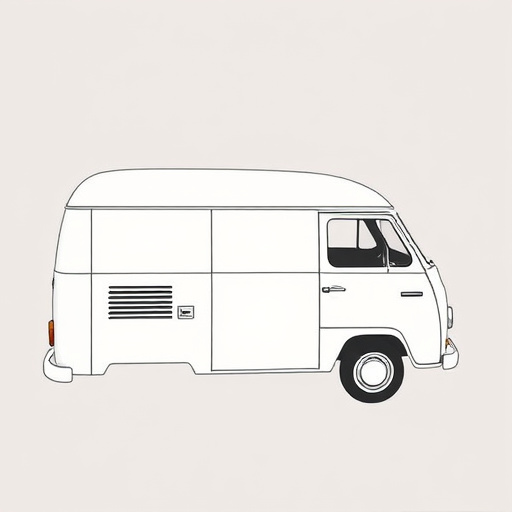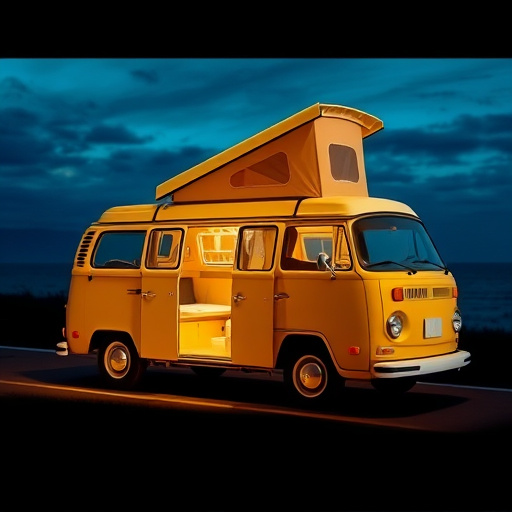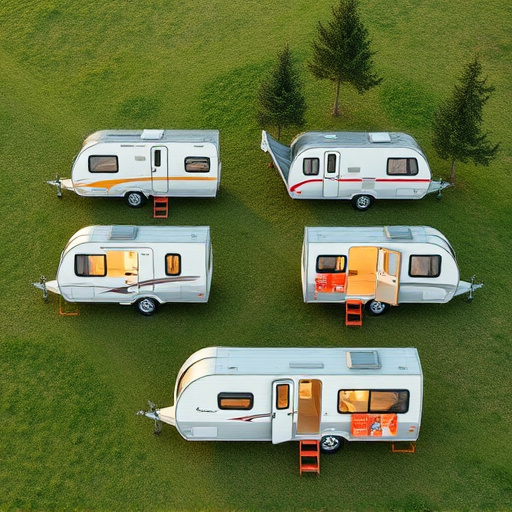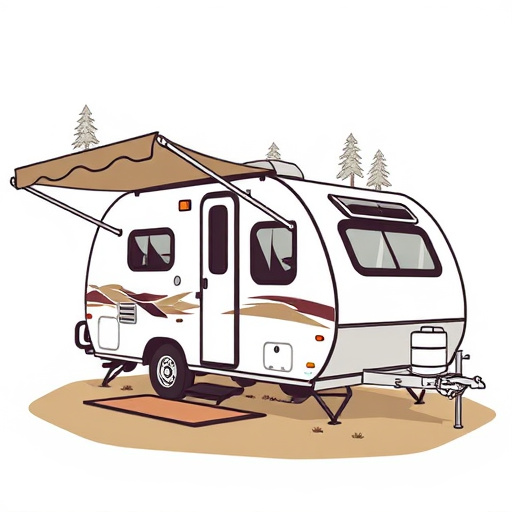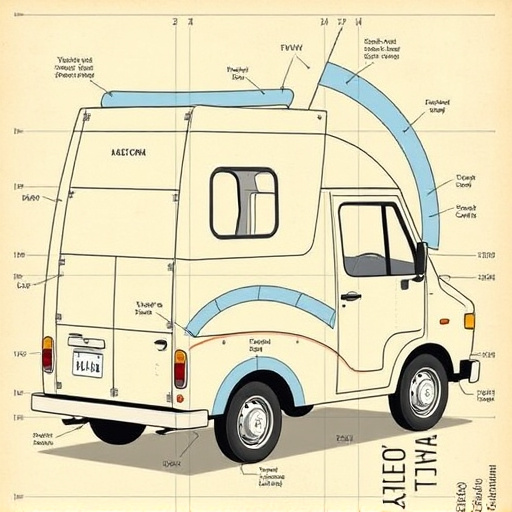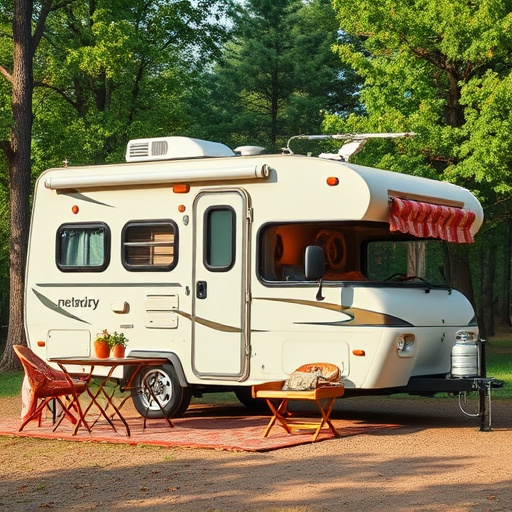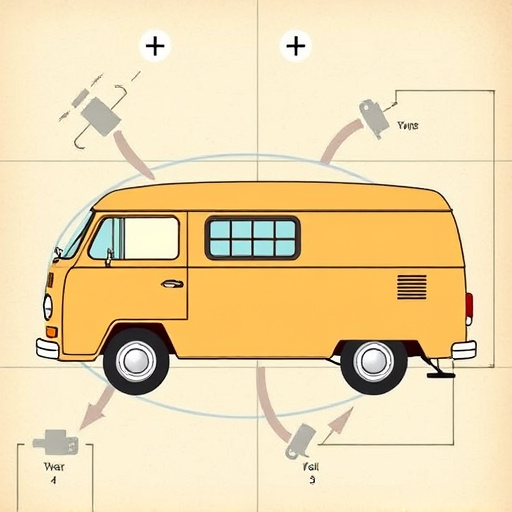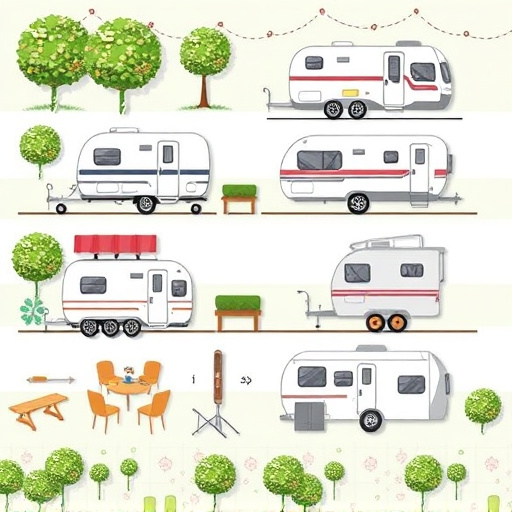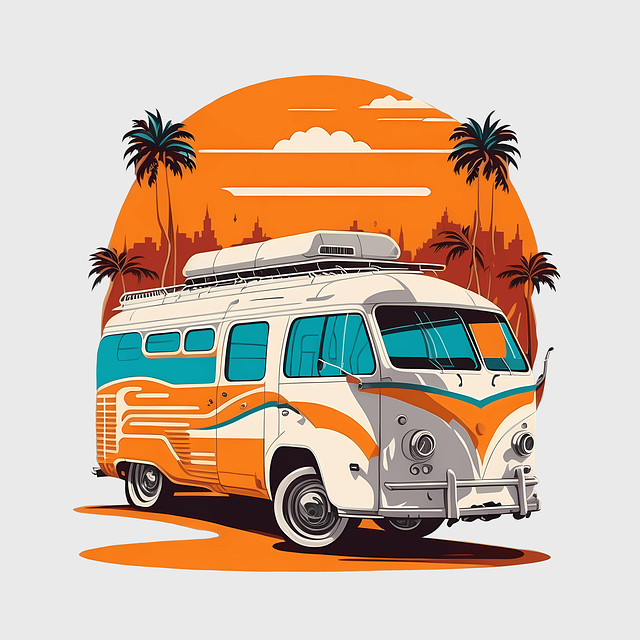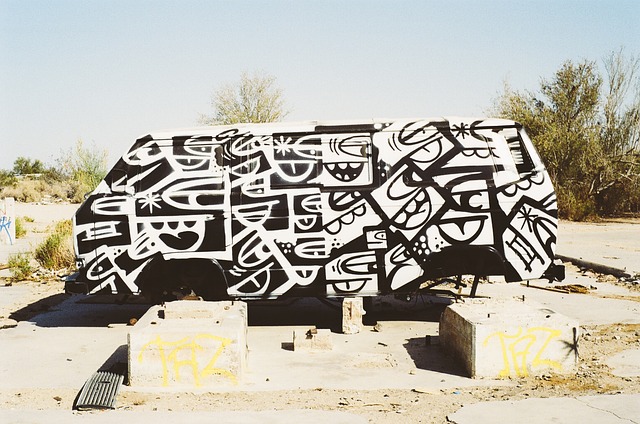Caravan Layouts: Unlocking the Future of Mobile Living
Introduction
Caravan layouts, an innovative concept in mobile housing, have emerged as a dynamic and adaptable living solution, gaining traction worldwide. This article delves into the intricate world of caravan design, exploring its various aspects, from historical roots to modern applications. By understanding the essence of caravan layouts, their global impact, economic implications, and technological innovations, we can appreciate their significance in shaping contemporary living practices. Through this comprehensive exploration, readers will gain insights into how these layouts are revolutionizing the way we think about mobile homes, offering a glimpse into a future where travel and comfort merge seamlessly.
Understanding Caravan Layouts: A Definition and Core Components
Caravan layouts, often referred to as RV (Recreational Vehicle) interiors or camping trailer designs, represent the art and science of creating functional and comfortable living spaces within a portable framework. These layouts are designed to provide residents with a sense of home while on the move, catering to various needs, from recreational travel to permanent living solutions.
At its heart, a caravan layout comprises several key components:
-
Space Utilization: Efficient use of limited space is paramount. Layouts often feature modular designs, utilizing every inch to accommodate sleeping areas, kitchens, dining spaces, and storage.
-
Comfort and Amenities: Modern caravan layouts prioritize comfort with amenities similar to those found in permanent homes. This includes comfortable bedding, well-appointed kitchens, entertainment systems, and even en-suite bathrooms in larger models.
-
Structural Integrity: The layout must be structurally sound, ensuring stability during transit and prolonging the vehicle’s lifespan through robust construction techniques and materials.
-
Customization: Many layouts offer customizable options, allowing owners to tailor their caravan to suit individual preferences and needs. This customization can range from furniture arrangements to specialized equipment for various activities.
Historically, caravan layouts have evolved over centuries, with early designs dating back to ancient civilizations that utilized mobile dwellings for trade and travel. However, it is in the 20th century that RVs gained popularity as recreational vehicles, leading to sophisticated and diverse layout designs we see today.
Global Impact and Trends: A World of Caravan Diversity
The concept of caravan layouts has transcended geographical boundaries, inspiring diverse interpretations worldwide. Each region’s unique cultural, climatic, and practical considerations have given rise to distinct layout trends:
-
North America: Known for its expansive RV industry, North America boasts a wide array of caravan layouts, from luxurious motorhomes to compact travel trailers. The vast open spaces encourage larger, more spacious designs, while technological advancements have enabled smart home features within these vehicles.
-
Europe: European caravans often prioritize comfort and efficiency, reflecting the region’s rich camping heritage. Layouts typically feature fold-out beds, sliding kitchens, and innovative storage solutions to maximize space.
-
Asia Pacific: In this diverse region, caravan layouts adapt to varied landscapes and climates. From rugged mountain trails in Nepal to tropical beaches in Australia, layouts range from lightweight, off-road capable vehicles to spacious, family-oriented caravans.
-
Middle East: With a growing preference for luxury travel, the Middle East has seen an increase in extravagant caravan layouts featuring opulent interiors, high-tech entertainment systems, and customized amenities.
These global trends showcase the versatility of caravan layouts, adapting to diverse needs and environments while retaining core principles of mobility and comfort.
Economic Considerations: A Growing Market with Diverse Dynamics
The economic landscape surrounding caravan layouts is dynamic and multifaceted:
-
Market Size and Growth: The global RV market has experienced steady growth, driven by factors such as rising disposable incomes, a desire for outdoor adventures, and the appeal of flexible living solutions. According to a 2022 report by Grand View Research, the global recreational vehicle market size was valued at USD 49.8 billion in 2021 and is expected to grow at a compound annual growth rate (CAGR) of 5.7% from 2022 to 2030.
-
Investment and Ownership Patterns: Caravan layouts offer various ownership options, including purchasing new or used vehicles, leasing, or membership in RV communities. The cost of entry varies widely, with basic travel trailers starting at relatively lower prices compared to custom-built motorhomes.
-
Economic Impact: The RV industry contributes significantly to local economies, supporting manufacturing, retail, and tourism sectors. In the United States, for instance, the RV industry generates over $120 billion in economic activity annually, according to the Recreation Vehicle Industry Association (RVIA).
-
Employment Opportunities: From manufacturing and sales to maintenance and campsite management, caravan layouts create employment opportunities across various sectors, fostering local job growth.
Technological Advancements: Digital Age Innovations in Caravan Layouts
Technology has played a pivotal role in transforming caravan layouts into modern, efficient, and connected living spaces:
-
Smart Home Integration: Many contemporary caravans now incorporate smart home technology, allowing owners to control lighting, temperature, and security remotely via smartphone apps. Voice-activated assistants and automated systems further enhance convenience and efficiency.
-
Solar Power and Energy Efficiency: With an increasing focus on sustainability, solar panels and energy-efficient appliances have become standard features in many caravan layouts. These innovations enable off-grid living and reduce operational costs.
-
GPS Navigation and Safety Features: Advanced GPS systems and driver assistance technologies improve safety during travel, providing real-time navigation, collision avoidance, and parking assistance.
-
Internet Connectivity: High-speed internet access in caravans is now more accessible than ever, thanks to satellite internet services and 4G/5G connectivity. This enables remote work, online entertainment, and seamless communication.
-
Virtual Reality (VR) and Augmented Reality (AR): VR and AR technologies offer immersive experiences within caravans, providing entertainment and educational content. These innovations could shape future layout designs by creating unique, interactive spaces.
Policy and Regulation: Navigating Legal Landscapes
The development and use of caravan layouts are subject to various policies and regulations that vary across jurisdictions:
-
Vehicle Registration and Licensing: Caravan owners must register their vehicles with relevant authorities, adhering to local laws regarding size, weight, and safety standards.
-
Building Codes and Zoning Laws: Layouts designed for permanent living may face restrictions in certain areas due to building codes and zoning regulations, impacting the construction and use of these vehicles.
-
Environmental Standards: To protect natural resources, environmental policies govern aspects like waste management, water usage, and energy efficiency in caravans.
-
Road Safety Regulations: Ensuring safe operation on roads is a priority, with regulations covering lighting, signaling, and safety equipment requirements.
-
Taxation and Subsidies: Governments may offer incentives or subsidies for purchasing energy-efficient or off-grid caravan layouts, promoting sustainable travel practices.
Challenges and Criticisms: Overcoming Barriers to Adoption
Despite their numerous advantages, caravan layouts face challenges that require careful consideration and innovative solutions:
-
Cost and Accessibility: High initial costs and limited accessibility to specialized knowledge and services can deter potential buyers, particularly in regions with a smaller RV industry.
-
Space Constraints: While efficient, caravan layouts may not accommodate larger families or specific lifestyle needs, requiring custom designs to meet diverse requirements.
-
Technical Complexity: As technology advances, the risk of technical failures increases, necessitating robust support systems and accessible repairs.
-
Environmental Concerns: Despite sustainability efforts, the manufacturing process for some caravan components raises environmental questions, prompting industry leaders to embrace eco-friendly practices.
To address these challenges, manufacturers, regulators, and community organizations can collaborate on strategies such as:
- Providing financial incentives or rental programs to make caravan layouts more accessible.
- Developing standardized layout designs catering to various family sizes and lifestyles.
- Establishing comprehensive training programs for technical support staff to ensure efficient repairs.
- Promoting sustainable manufacturing practices and recycling initiatives within the industry.
Case Studies: Real-World Success Stories
1. The Tiny House Movement Meets RV Design
In the United States, a growing trend combines tiny house aesthetics with caravan layout efficiency. Companies like Dyrden International have created compact, off-grid caravans with minimalist designs, appealing to environmentally conscious travelers. These vehicles offer a cost-effective, sustainable solution for those seeking a simple, mobile lifestyle.
2. Luxury Camping in the Australian Outback
Australia’s RV industry has seen a surge in high-end, luxurious caravan layouts tailored for the country’s rugged landscapes. Companies like Jayco have developed models featuring expansive living areas, gourmet kitchens, and custom entertainment systems, catering to affluent travelers seeking comfort and style during their adventures.
3. Community Living on Wheels
Some organizations embrace caravan layouts as a means of fostering community engagement and social support. For example, “Roaming Roots” in Europe encourages families to travel together in customized caravans, creating a supportive network for like-minded individuals while exploring diverse cultures. This concept promotes a sense of belonging and shared experiences.
Future Prospects: Exploring New Horizons
The caravan layout market is poised for significant growth and innovation as technology continues to shape the future of mobile living:
-
Sustainable Living Solutions: With increasing environmental awareness, eco-friendly caravan layouts will likely gain prominence, featuring renewable energy sources, water conservation systems, and biodegradable materials.
-
Smart Home Integration Deepens: As smart home technology advances, caravans will become increasingly connected, with automated systems managing lighting, temperature, security, and entertainment, providing a seamless living experience.
-
Customizability and Personalization: Future layouts may offer advanced customization options, allowing owners to design their vehicles to reflect individual personalities and preferences, from interior themes to specialized equipment.
-
Global Market Expansion: With growing acceptance and infrastructure support, the RV industry is expected to expand globally, particularly in regions with emerging middle classes and a culture of outdoor recreation.
-
Technologies like 3D Printing and Modular Construction: These innovative manufacturing techniques could revolutionize caravan production, enabling faster, more efficient, and cost-effective layout designs.
Conclusion: A Mobile Future Unveiled
Caravan layouts represent a dynamic and ever-evolving aspect of modern living, offering a unique blend of mobility, comfort, and customization. As technology advances and global trends shape the industry, these layouts are becoming increasingly sophisticated and accessible. From sustainable travel to luxury on wheels, caravan designs cater to diverse lifestyles and aspirations.
By understanding the historical context, global impact, economic considerations, technological advancements, policies, challenges, and successful applications, we can appreciate the significance of caravan layouts in today’s world. As we look ahead, the future holds immense potential for this concept, promising exciting developments that will continue to shape the way we think about home, travel, and living.
FAQ: Answering Common Queries
Q: What are the initial costs involved in owning a caravan layout?
A: Initial costs can vary widely depending on the type of caravan (motorhome, travel trailer, etc.), size, brand, and features. Basic models start at around $10,000 USD, while high-end layouts can exceed $200,000 USD. Used caravans offer a more affordable entry point.
Q: How do I choose the right caravan layout for my family?
A: Consider your family’s size, lifestyle, and specific needs. Evaluate space allocation, sleeping arrangements, kitchen amenities, and storage. Test drive different models to get a feel for comfort and practicality. Customization options can also be tailored to your family’s preferences.
Q: Are caravan layouts suitable for full-time living?
A: Absolutely! Many people live in caravans full-time, embracing a nomadic lifestyle. However, ensure you have reliable access to services like water, electricity, and internet connectivity. Full-time living may also require careful planning for waste management, healthcare, and community engagement.
Q: How do I maintain the interior of my caravan layout?
A: Regular cleaning and maintenance are essential. Use appropriate cleaning products for different surfaces, and address issues promptly to prevent damage. Establish a routine maintenance schedule, including checks for water leaks, tire pressure, and battery health.
Q: Are there any tax benefits associated with owning a caravan?
A: Yes, in some countries, there may be tax incentives or deductions for purchasing energy-efficient or off-grid caravan layouts. Check local tax regulations to determine if you qualify for any savings.
Vacationer caravans have emerged as a popular choice for modern travelers seeking both comfort and mobility. These vehicles offer a unique blend of home-like amenities, including slide-out sections that expand living spaces and dedicated enterta…….
Continue Reading
Vacationer Caravans revolutionize compact living with their innovative single axle design, offering fully equipped kitchens, comfortable sleeping areas, and ample storage in a streamlined package. Their clever floor plans, foldable furniture, an…….
Continue Reading
Vacationer caravans have gained immense popularity for leisure travel due to their appeal to families and groups seeking both adventure and comfort. These all-in-one vehicles offer modern amenities like fully equipped kitchens and entertainment…….
Continue Reading
Caravan layouts have evolved to offer modern travelers diverse and innovative options. Key features include slide-out sections for expanded living, entertainment zones for family bonding, comfortable bedding and storage for relaxation, efficient…….
Continue Reading
Understanding caravan layouts is key to choosing the perfect vacationer caravan for unforgettable offroad vacations. From compact to luxurious designs, each offers unique benefits based on space needs and travel styles. Key considerations includ…….
Continue Reading
Caravan layouts are crucial for crafting comfortable and functional vacationer experiences, catering to personal lifestyles and needs. By balancing space, natural light, storage, and design, modern caravans transform into cozy homes, offering op…….
Continue Reading
Open-plan caravan layouts have revolutionized traditional travel accommodations by offering spacious, versatile living areas for modern families and groups. These innovative designs maximize space, enhance functionality, and promote social inter…….
Continue Reading
Vacationer Caravans are gaining popularity for their blend of comfort and adventure, offering cozy home-like environments with modern amenities while exploring new destinations. Their versatility, security, and on-the-road comforts make them an…….
Continue Reading
Vacationer Caravans offer a flexible and comfortable way to explore new places, catering to diverse travel needs with customizable layouts and smart amenities. Featuring queen-sized beds for exceptional comfort, efficient storage solutions, and…….
Continue Reading
Modern couples seek flexible, compact yet functional spaces for both relaxation and adventure, driving a revival of caravanning. Vacationer Caravans meet this demand with dynamic layouts, home-like amenities, and smart design, catering to today&…….
Continue Reading
Caravan layouts have evolved significantly, transforming into spacious and functional homes on wheels that offer comfort akin to traditional homes. Modern design incorporates open-plan spaces for social interactions or private zones, catering to…….
Continue Reading
Vacationer caravans, or recreational vehicles (RVs), have evolved significantly, offering diverse layouts and amenities to cater to various lifestyle requirements for leisure travel. From compact models suitable for couples to spacious families&…….
Continue Reading
For extended vacation journeys, optimizing caravan layouts is crucial. These designs prioritize comfort, versatility, and space efficiency, featuring well-lit, accessible floorplans with functional kitchens, comfortable sleeping quarters, and ad…….
Continue Reading
Planning a family camping trip? Vacationer Caravans helps find the perfect caravan layouts based on your needs, from compact for small families to spacious for larger groups. Their diverse range caters to various preferences, offering comfortabl…….
Continue Reading
Caravan layouts vary greatly in comfort and functionality, with the rear club lounge design gaining popularity for its spacious living area at the back, ideal for families or groups. This layout emphasizes indoor-outdoor flow through large windo…….
Continue Reading
Vacationer Caravans are revolutionizing travel with their flexible interior layouts that cater to diverse traveler needs and preferences. These caravans allow users to rearrange interiors for various activities, accommodate different group sizes…….
Continue Reading
Australian road trips are a cultural staple, and Vacationer Caravans have emerged as the perfect mobile home solution. These caravans offer spacious interiors, home-like amenities, and comfort for both adventurous spirits and those seeking relax…….
Continue Reading
Vacationer caravans have emerged as a popular choice for modern travelers seeking comfort, mobility, and luxury. These self-contained vehicles offer home-like amenities like full ensuite facilities and well-equipped kitchens, providing a unique…….
Continue Reading
Vacationer Caravans offer flexible, comfortable ways to explore new places, with diverse sizes and layouts catering to individual lifestyles and budgets. Online tools and resources make exploring these layouts easy, providing detailed virtual to…….
Continue Reading
